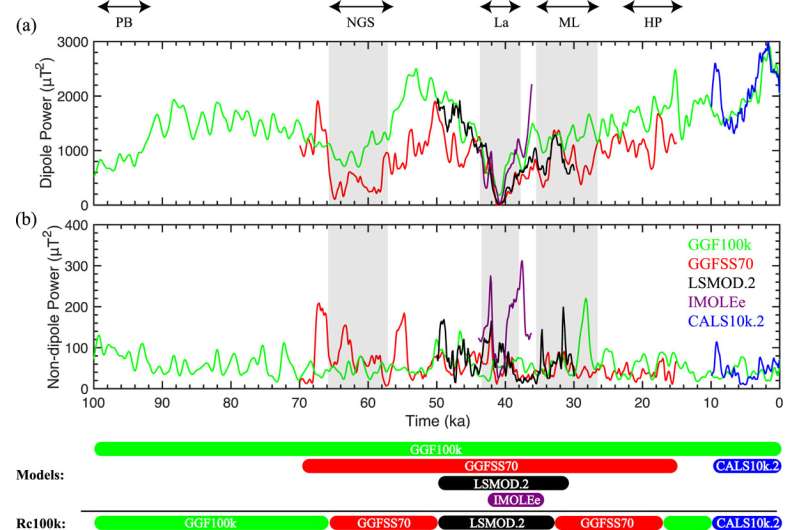This article has been reviewed according to Science X's editorial process and policies. Editors have highlighted the following attributes while ensuring the content's credibility:
fact-checked
trusted source
proofread
Study models geomagnetic field shielding over the last 100,000 years

New models of how the geomagnetic field that shields the Earth's atmosphere from cosmic rays has changed over tens of thousands of years can help us understand how the climate has changed over a similar timescale.
The Earth's atmosphere is shielded from the impact of cosmic rays and other energetic, charged particles by a magnetic field—the geomagnetic field—that extends into space from our planet's molten outer core. The strength of the geomagnetic field is not constant but varies over timescales of thousands and tens of thousands of years.
Now, a group of scientists from China and Germany, led by Jiawei Gao of the Institute of Geology and Geophysical Sciences, Chinese Academy of Sciences, Beijing has modeled the fluctuations in the field over the last 100,000 years. Their research is published in the Journal of Space Weather and Space Climate.
The geomagnetic field is a natural phenomenon but a very beneficial one as it protects the Earth's atmosphere from the impact of cosmic rays and other energetic particles, which produce long-lived radionuclides such as carbon-14. When it weakens, the flux of cosmic rays reaching the Earth increases. We know, for instance, that every few tens of thousands of years the field suffers an "excursion" or "reversal" that significantly decreases its strength and weaker, more rapid fluctuations are superimposed on such long-term changes.
"The global cosmic ray flux reaching the Earth's atmosphere was up to three times higher at the mid-point of the so-called Laschamps excursion, about 34,000 years ago, than it is today, and about twice as high in another excursion about 65,000 years ago," says Gao.
Understanding these changes over time can help us understand long-term patterns in solar activity and the non-anthropogenic changes in the climate, that is, those not caused by human activity, that have occurred throughout prehistory. It is possible to measure the strength of the geomagnetic field shielding using a parameter of momentum per unit charge known as "rigidity."
Charged particles with equal rigidity move in the same way. If you examine all charged particles moving towards the atmosphere at a given location and incidence angle, then only those with rigidity higher than a certain value will be able to penetrate it. That value, or the "geomagnetic cutoff rigidity" is a direct measure of the geomagnetic field strength and, thus, of the degree of shielding.
Gao and his co-workers estimated the global cutoff rigidity, using the geomagnetic field models at individual time intervals during the last 100,000 years, by comparing and combining four different models of the field.
"The first models were based on dipole field assumptions. Advanced geomagnetic field models all include non-dipole components as well, which are more accurate than those involving dipole components alone," he says. "Using these models, we found that, during excursions (that is, when the field strength is low) the flux of energetic cosmic rays into the atmosphere was high and, furthermore, it was nearly independent of latitude."
These "best available" models developed by the research team allow scientists to estimate the radionuclide production rate and thus the cosmic radiation dose rate and solar activity throughout this period. This will help them explore how the climate has changed throughout prehistory, which should provide useful insights into the mechanisms and effect of anthropogenic climate change today. Although high energy particles originating from outside the solar system can influence the Earth's climate, there is a scientific consensus that these factors are not responsible for the warming trend we've seen over recent decades. Recent global warming and associated climate changes are attributed to human activities, in particular greenhouse gas emissions.
More information: Jiawei Gao et al, Geomagnetic field shielding over the last one hundred thousand years, Journal of Space Weather and Space Climate (2022). DOI: 10.1051/swsc/2022027
Provided by Springer





















